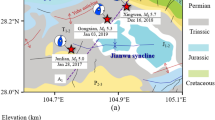Abstract
Shear-wave splitting parameters of 24 stations in southeastern Capital area of North China (38.5°N∼39.85°N, 115.5°E ∼118.5°E) are obtained with systematic analysis method of shear-wave splitting (SAM) based on the data recorded by Capital Area Seismograph Network (CASN) from 2002 to 2005. The results show that the average polarization of fast shear-wave in southeastern Capital area is consistent with regional maximum horizontal principal compressive stress in the area, and is also consistent with maximum horizontal principal compressive strain from GPS in North China. The average shear-wave splitting in southeastern Capital area (in basin) is different from that in northwestern Capital area where uplifts and basin exist, which means that tectonics can be related to shear-wave splitting results. Research also shows that the distribution of faults around stations can obviously affect the shear-wave splitting results, and complicated distribution of faults can result in much more scatter of shear-wave splitting. Moreover, in the north and south of the studied area (southeastern Capital area), the polarizations of fast shear-wave are not very consistent, which may be related to differences in tectonic and stress for the two areas.
Similar content being viewed by others
References
Crampin S. 1978. Seismic wave propagation through a cracked solid: Polarization as a possible dilatancy diagnostic [J]. Geophys J R astr Soc, 53: 467–496.
Crampin S and Gao Y. 2006. A review of techniques for measuring seismic shear-wave splitting above small earthquakes [J]. Phys Earth Planet Inter, 159(1/2): 1–14.
Crampin S and Peacock S. 2005. A review of shear-wave splitting in the compliant crack-critical anisotropic Earth [J]. Wave Motion, 41: 59–77.
Crampin S, Volti T, Chastin S, et al. 2002. Indication of high pore-fluid pressures in a seismically-active fault zone [J]. Geophys J Int, 151:F1–F2.
Gao Y and Crampin S. 2003. Temporal variations of shear-wave splitting in field and laboratory studies in China [J]. J Appl Geophys, 54:279–287.
GAO Yuan, ZHENG Si-hua, SUN Yong. 1995. Crack-induced anisotropy in the crust from shear wave splitting observed in Tangshan region, North China [J]. Acta Seismologica Sinica, 8(3): 351–363.
GAO Yuan, ZHENG Si-hua, ZHOU Hui-lan. 1999. Polarization patterns of fast shear wave in Tangshan region and their variations [J]. Chinese J Geophys, 42(2): 228–232 (in Chinese).
GAO Yuan, LIU Xi-qiang, LIANG Wei, et al. 2004. Systematic analysis method of shear-wave splitting: SAM software system [J]. Earthquake Research in China, 18(4): 365–372.
HUANG Jin-li and ZHAO Da-peng. 2005. Three dimensional P wave velocity tomography and deep structure related to strong earthquake in Beijing area [J]. Chinese Science Bulletin, 50(4): 348–355 (in Chinese).
Jia S, Qi C, Wang F, Chen Q, et al. 2005. Three-dimensional crustal gridded structure of the Beijing area [J]. Chinese J Geophys, 48(6): 1 316–1 324.
JIANG Zai-sen, ZHANG Xi, CHEN Bing, et al. 2000. Characteristics of recent horizontal movement and strain-stress field in the crust of North China [J]. Chinese J Geophys, 43(5): 657–665 (in Chinese).
LAI Yuan-gen, LIU Qi-yuan, CHEN Jiu-hui, et al. 2006. Shear wave splitting and the features of the Crustal stress field in the Capital circle [J]. Chinese J Geophys, 49(1): 189–196 (in Chinese).
Müller C. 2001. Upper mantle seismic anisotropy beneath Antarctica and the Scotia Sea region [J]. Geophys J Int, 147: 105–122.
Peng Z and Ben-Zion Y. 2004. Systematic analysis of crustal anisotropy along the Karadere-Duzce branch of the North Anatolian fault [J]. Geophys J Int, 159: 253–274.
SHI Yu-tao, GAO Yuan, WU Jing, et al. 2006. Seismic anisotropy of the crust in Yunnan, China: Polarizations of fast shear-waves [J]. Acta Seismologica Sinica, 19(6): 620–632.
WANG Fu-yun, ZHANG Xian-kang, CHEN Qi-fu, et al. 2005. Fine tomographic inversion of the upper crust 3-D structure around Beijing [J]. Chinese J Geophys, 48(2): 359–366 (in Chinese).
WU Jing, GAO Yuan, CHEN Yun-tai, et al. 2007. Seismic anisotropy in crust in Northwest Beijing area [J]. Chinese J Geophys, 50(1): 210–221 (in Chinese).
XU Zhong-huai. 2001. A present-day tectonic stress map for eastern Asia region [J]. Acta Seismologica Sinica, 14(5): 524–533.
YAOI Chen, WANG Pei-de, CHEN Yun-tai. 1992. S polarization and upper-crust crack anisotropy in Lulong area [J]. Chinese J Geophys, 35(3): 305–315 (in Chinese).
Zatsepin S V and Crampin S. 1997. Modelling the compliance of crustal rock (I): Response of shear-wave splitting to differential stress [J]. Geophys J Int, 129: 477–494.
ZHANG Guo-min, MA Hong-sheng, WANG Hui, et al. 2004. The relation between active blocks and strong earthquakes in China [J]. Science in China (Ser. D), 34(7): 591–599 (in Chinese).
Zhang Z, Li Y, Lu D, et al. 2000. Velocity and anisotropy structure of the crust in the Dabieshan orogenic belt from wide-angle seismic data [J]. Phys Earth Planet Inter, 122: 115–131.
ZHUANG Can-tao. 1999. Technical composition of the digital telemetry seismic network in Capital Zone [J]. Seismological and Geomagnetic Observation and Research, 20(5): 23–28 (in Chinese).
Author information
Authors and Affiliations
Corresponding author
Additional information
Foundation Item: Seismic Professional Science Fund (200708008), Basic and Special Research Foundation, Institute of Earthquake Science, China Earthquake Administration (2007-13) and National Natural Science Foundation of China (40674021).
Contribution No. 07FE3004, Institute of Geophysics, China Earthquake Administration.
About this article
Cite this article
Wu, J., Gao, Y. & Chen, Yt. Crustal seismic anisotropy in southeastern Capital area, China. Acta Seismol. Sin. 21, 1–10 (2008). https://doi.org/10.1007/s11589-008-0001-2
Received:
Accepted:
Issue Date:
DOI: https://doi.org/10.1007/s11589-008-0001-2




